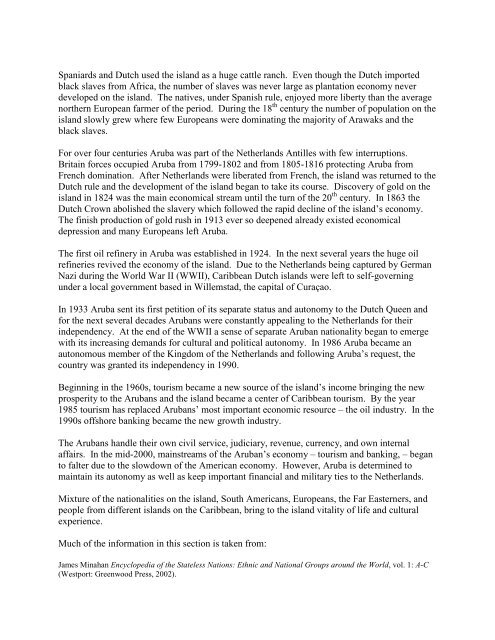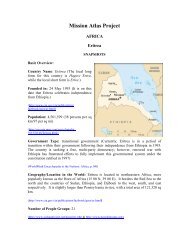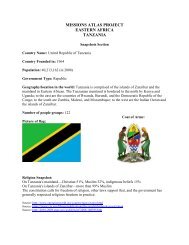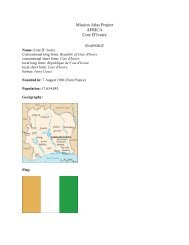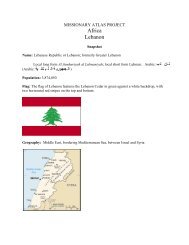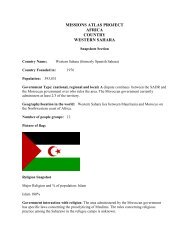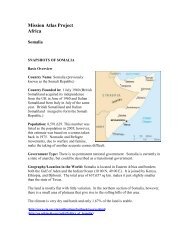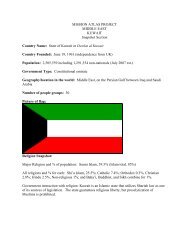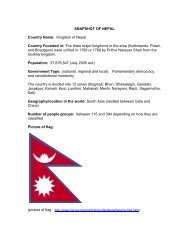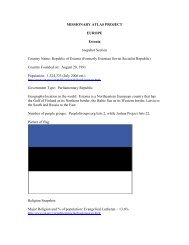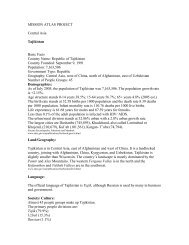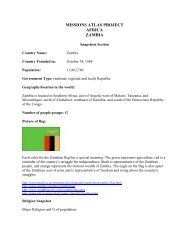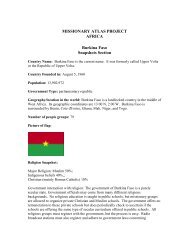ARUBA Profiile.pdf - WorldMap
ARUBA Profiile.pdf - WorldMap
ARUBA Profiile.pdf - WorldMap
Create successful ePaper yourself
Turn your PDF publications into a flip-book with our unique Google optimized e-Paper software.
Spaniards and Dutch used the island as a huge cattle ranch. Even though the Dutch imported<br />
black slaves from Africa, the number of slaves was never large as plantation economy never<br />
developed on the island. The natives, under Spanish rule, enjoyed more liberty than the average<br />
northern European farmer of the period. During the 18 th century the number of population on the<br />
island slowly grew where few Europeans were dominating the majority of Arawaks and the<br />
black slaves.<br />
For over four centuries Aruba was part of the Netherlands Antilles with few interruptions.<br />
Britain forces occupied Aruba from 1799-1802 and from 1805-1816 protecting Aruba from<br />
French domination. After Netherlands were liberated from French, the island was returned to the<br />
Dutch rule and the development of the island began to take its course. Discovery of gold on the<br />
island in 1824 was the main economical stream until the turn of the 20 th century. In 1863 the<br />
Dutch Crown abolished the slavery which followed the rapid decline of the island‟s economy.<br />
The finish production of gold rush in 1913 ever so deepened already existed economical<br />
depression and many Europeans left Aruba.<br />
The first oil refinery in Aruba was established in 1924. In the next several years the huge oil<br />
refineries revived the economy of the island. Due to the Netherlands being captured by German<br />
Nazi during the World War II (WWII), Caribbean Dutch islands were left to self-governing<br />
under a local government based in Willemstad, the capital of Curaçao.<br />
In 1933 Aruba sent its first petition of its separate status and autonomy to the Dutch Queen and<br />
for the next several decades Arubans were constantly appealing to the Netherlands for their<br />
independency. At the end of the WWII a sense of separate Aruban nationality began to emerge<br />
with its increasing demands for cultural and political autonomy. In 1986 Aruba became an<br />
autonomous member of the Kingdom of the Netherlands and following Aruba‟s request, the<br />
country was granted its independency in 1990.<br />
Beginning in the 1960s, tourism became a new source of the island‟s income bringing the new<br />
prosperity to the Arubans and the island became a center of Caribbean tourism. By the year<br />
1985 tourism has replaced Arubans‟ most important economic resource – the oil industry. In the<br />
1990s offshore banking became the new growth industry.<br />
The Arubans handle their own civil service, judiciary, revenue, currency, and own internal<br />
affairs. In the mid-2000, mainstreams of the Aruban‟s economy – tourism and banking, – began<br />
to falter due to the slowdown of the American economy. However, Aruba is determined to<br />
maintain its autonomy as well as keep important financial and military ties to the Netherlands.<br />
Mixture of the nationalities on the island, South Americans, Europeans, the Far Easterners, and<br />
people from different islands on the Caribbean, bring to the island vitality of life and cultural<br />
experience.<br />
Much of the information in this section is taken from:<br />
James Minahan Encyclopedia of the Stateless Nations: Ethnic and National Groups around the World, vol. 1: A-C<br />
(Westport: Greenwood Press, 2002).


